The 2015 Razer Blade Review
by Brett Howse on February 11, 2015 2:00 PM EST- Posted in
- Laptops
- Razer
- Razer Blade
- Notebooks
- GTX970M
Battery Life
The Razer keeps the same 70 Wh battery capacity as last year, but has a 47 watt CPU now instead of a 37 watt CPU. For our battery tests, Optimus should keep the GTX 970 turned off, so it should not affect our scores. Razer saw a regression in battery life last year when they moved to the High DPI display, and we do not want to see this again.
Razer is also shipping a new 1080p non touch model this year. With the lower screen density, and fewer pixels to drive by the integrated GPU, battery life for that model should be above and beyond what we see here, but we will not know for sure unless we can get one to test. We have reached out to Razer for a sample, and will provide the results if we are able to get one.
For consistent results, we calibrate the display to 200 nits. On the model was received, this was 45% brightness. We then perform a series of tests multiple times and record how long the device lasts before shutting down. Laptops are configured to use the Power Saving mode in the power options to maximise battery life. Our first test is our light test, which consists of light web browsing.
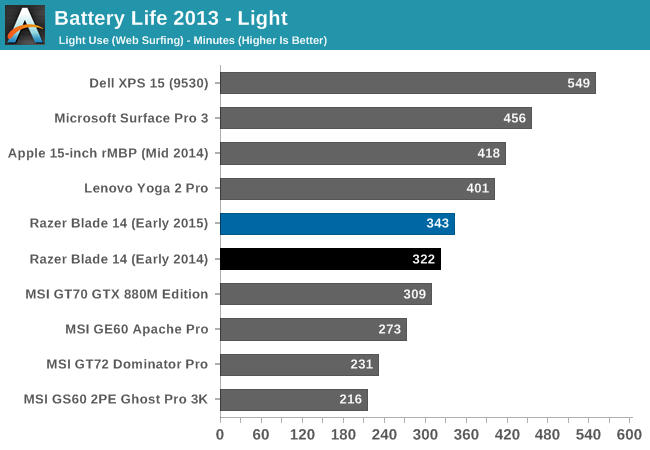
Luckily the higher wattage CPU did not cause a battery life hit under light loads. In fact, this year we were able to squeeze an extra twenty minutes out of the Blade than last year. It is still short of the 2013 model, which only had a 1600x900 display, and well back of the 95 Wh equipped Retina MacBook Pro and 91 Wh Dell XPS 15. High DPI has its price, and battery life is it.
Next we ramp up the workload, with a movie, heavier web browsing, and a 1 Mbps file download happening concurrently.
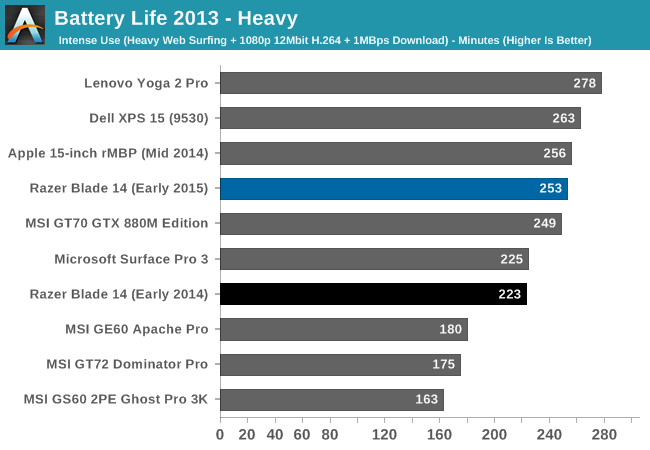
Our heavy test saw a nice jump in battery life with this test, coming in about 30 minutes higher than last year. It is a good result, coming in very close to the 2013 Blade, as well as the rMPB and XPS 15, both of which have much larger batteries.
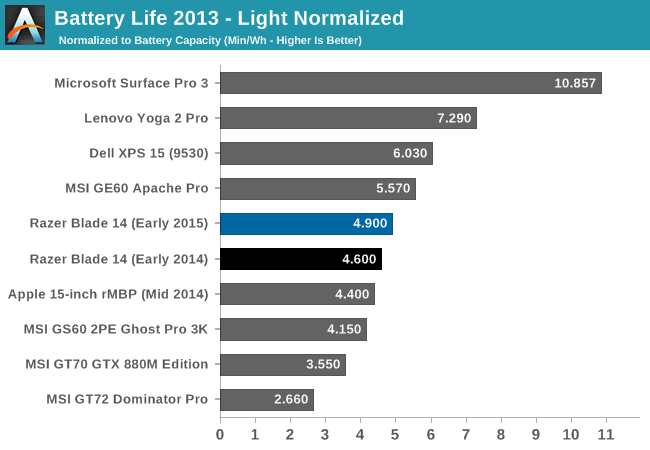
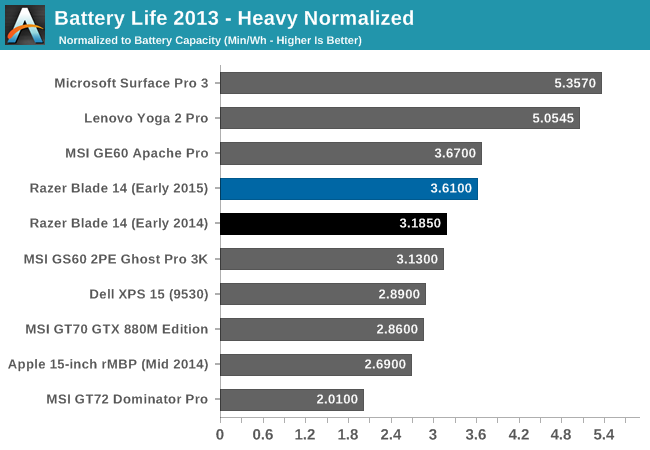
Normalizing the graphs removes the battery capacity from the scores, and lets us take a look at each platform’s overall efficiency. The 2015 model jumps up nicely over the 2014 model. The high resolution display is a big draw, but Razer has done a nice job reducing its impact on the overall battery life.
Gaming Battery Life – NVIDIA Battery Boost
NVIDIA has settings to allow games to be auto configured to run with different settings depending on whether you are plugged in, or running off battery power. The goal is to allow for a longer gaming experience when mobile. Our results have been mixed on it so far, and a lot of it comes down to the individual game in question. Battery Boost caps the frame rate, allowing the GPU to draw less power. In practice, there are a lot of factors involved which come into play. If you are playing a demanding game that is already close to the framerate cap, Battery Boost is not going to be able to make a huge difference anyway.
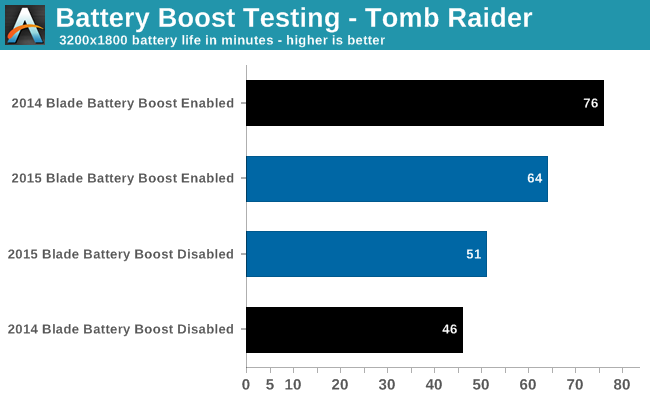
The difference is not huge with this game at the default GeForce Experience settings. Playing a less demanding game could show bigger gains here, but in my experience, keep the power cord handy if you are gaming. A high power CPU and GPU just will not lead to good battery life if they are being stressed.
Temperatures
The Razer Blade gets hot. The first one got hot, the second one got hot, and this one gets hot. There is a quite powerful CPU and GPU sitting under the keyboard, and they can both generate lots of heat when being pushed to their maximum. The air intakes are on the bottom, and exhaust out the vent between the back of the laptop and the display, so the hottest part is the center near the hinge. At the same ambient of 21°C, temperatures were not quite as high as we saw last year, but still very toasty at over 50°C at the power button.
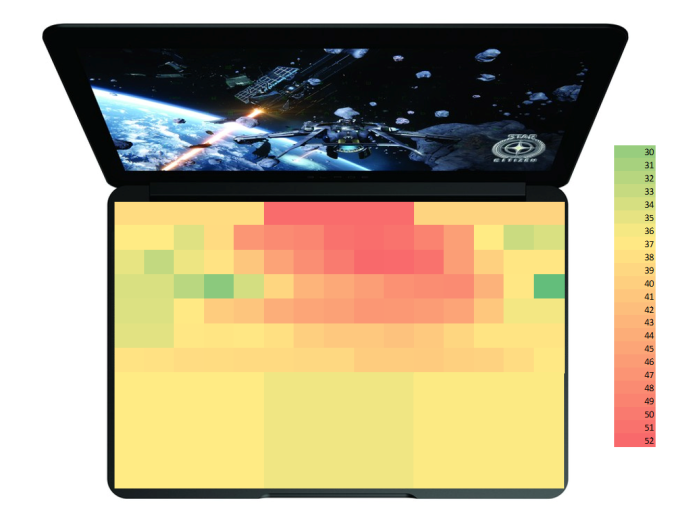 Razer Blade Temperatures after one hour of 3200x1800 gaming (Tomb Raider)
Razer Blade Temperatures after one hour of 3200x1800 gaming (Tomb Raider)
The graphic shows the hot spots on this laptop. Top center is the hottest, but the rest of the laptop is warm, but usable. There is a lot of heat to be moved out of this chassis.
To test and see if the GPU throttles under prolonged use, we checked it running the Tomb Raider benchmark for a couple of hours.
As you can see, the GPU load is completely flat, and the GPU core clock does not move at all over the duration. The only change was in the GPU temperature, which would rise up, causing the fans to increase in speed, and then it would fall down again and repeat.
Noise
Razer has tuned the fans to stay as quiet as possible. The laptop is almost dead silent under most light workloads, and then as you begin gaming, the speed will ramp up. Depending on the gaming load, fan speeds may increase for a bit, but they always seem to want to get down to the lowest speed possible to keep system noise down.
When the fans are running though, the laptop is very loud. We measured 55.0 dBA at 1 inch from the system after one hour of gaming. It is very loud, and very noticeable. In my opinion, any gaming on the Razer Blade would necessitate headphones unless the sound of fan noise does not bother you. There is a lot of heat generated inside the small chassis, and the fans have to expel that.


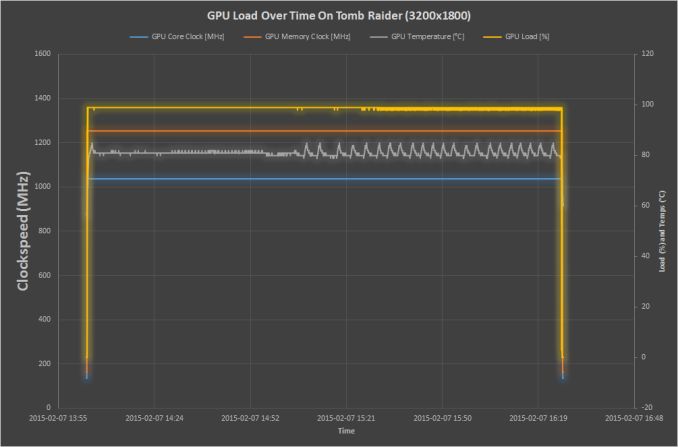








116 Comments
View All Comments
peterfares - Thursday, February 12, 2015 - link
There are lots of issues with HDMI 1.4 and 2560x1440. Most don't seem to be able to do 2560x1440 at 60Hz.http://www.notebookcheck.net/2560x1440-or-2560x160...
Most of these tests were able to get 55Hz after setting a custom resolution. I tried once to get 2560x1440 60Hz out of a laptop with only HDMI and I couldn't do it whereas my laptops with DisplayPort I can just plug in and it works.
close - Thursday, February 12, 2015 - link
It doesn't mimic anything. It's just a good design. It's like saying that all cars mimic the Ford Model T or something. It is a shame indeed that it lack some connectivity but if they actually did study the market and most of their potential customers wanted this it sounds reasonable enough.Jaisah - Thursday, September 3, 2015 - link
The body is almost identical to the rMBP and even the inside (fan positioning, soldered ram and location, speaker position, battery position) looks very similar to the rMPB. Maybe they didn't copy the rMBP but they certainly used it for inspiration :PUplink10 - Wednesday, February 11, 2015 - link
Why do people buy laptops with pricey gimped i7 CPUs, which cost the same as ungimped CPUs. They should make laptop with i5 desktop CPU which is much cheaper but it is not gimped and has the same performance.dragonsqrrl - Wednesday, February 11, 2015 - link
... and a far higher TDP.Oh and the answer to your question: TDP (probably package size as well)
anactoraaron - Wednesday, February 11, 2015 - link
What? Did you just start reading AT? They analyzed this not too long ago. http://www.anandtech.com/show/7287/analyzing-the-p... The higher end quad w/ht i7 laptop chips hold their own against any desktop i5... and at a much lower tdp. I'm not sure how you define gimpedUplink10 - Wednesday, February 11, 2015 - link
They could have higher clocks but also a little higher TDP.DanNeely - Thursday, February 12, 2015 - link
Because at about the same TDP the mobile i7 is faster than the desktop i5. The 47W i7-4720m has a base of 2.6ghz and can turbo to 3.4-3.6. The 45W i5-4690T only has a base of 2.5GHz and tops out at 3.1-3.5 for turbo. The overall TDP between the two chips is closer because the desktop chipset is 4.1W vs 2.7 for the mobile one. To get faster than a baseline mobile i7 you need to go to the 65W S series i5s. Normal laptops don't do that because an extra 20W of TDP will give much better returns most of the time with a faster GPU. You'll occasionally see a desktop CPU it in an 18-19" luggable; but other than in form factor those machines don't really qualify as laptops because they're too big, too heavy, and have too little battery life even at idle to be usable away from a desk.And even at that, in turbo mode the top end end mobile 47W i7-4980HQ is faster than the 88w desktop i5.
Uplink10 - Thursday, February 12, 2015 - link
I thought you generally have laptop plugged in when playing games. And when you do not play games for few hours, you can use a CPU with little higher TDP.Brett Howse - Thursday, February 12, 2015 - link
It's not about battery life. You have to get the heat out. On a desktop PC, the headsink and fan combo is 3-4 times thicker than the entire laptop. Next, look at the cooling solution on a GTX 970 desktop part and then look at the laptop.